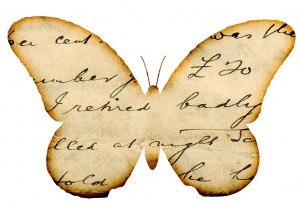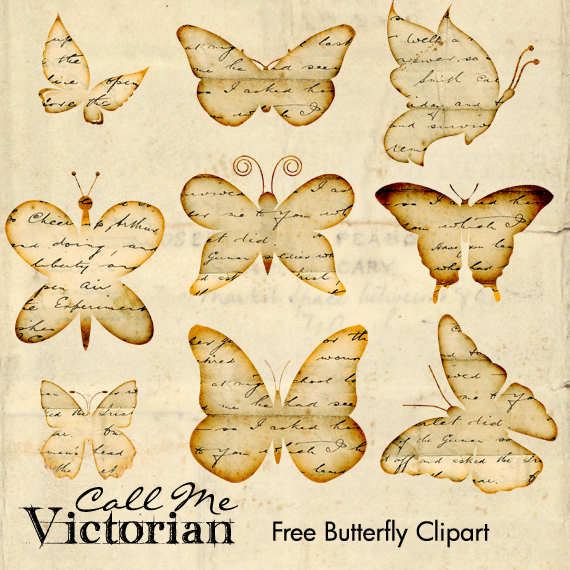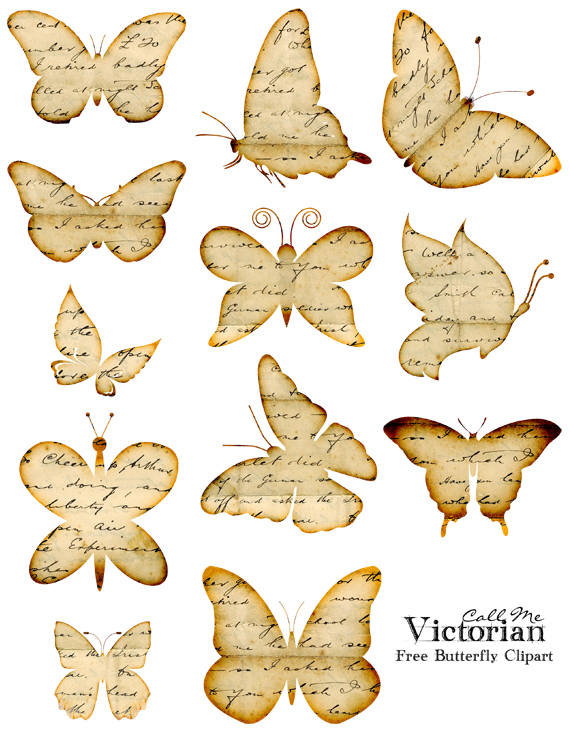I’ve created this free collection of butterfly clipart made with distressed vintage handwriting paper overlay and darkened edge. The file is a transparent PNG that can be printed out on letter sized paper, or each image can be used in their digital state as clipart on the web. The Butterfly was once an inspiration for the colors of gorgeous Gowns, handmade rugs, and artful stained glass windows. Read below the information about how the butterfly inspired artists and craftsmen for centuries:
Where have artists obtained all the beautiful color schemes which seem to spring full-fledged from the recesses of their brains? Where have the creators of marvelous-hued gowns, robes, and costly wraps found their enchanting combinations? Where have the weavers of the incomparable handmade rugs and carpets procured the delicate, elusive harmonies in color which are a regal source of delight to the eye, and where do the milliners – lords of taste and fancy – find the felicitous contrasts which make a chic hat look as if one had been born in it?
Where indeed? Not from the brains of artists, color schemers though they be; not from the clever designers of gowns, the happy thought of the milliner, or the skill of he far away intricate weaver of India can this wonderful riot of colors be evolved. Where then? And the answer is: from the butterfly.
Yes, from the butterfly – that fragile and perishable “creature of an hour” have artists and designers drawn their most subtle inspiratio ns. They have conceded their due to the matchless insect and admitted its superlative worth. It is not a new idea, this of utilizing the butterfly as a study in suggestion for new color harmonies, for the lover of color knew the practical use of the butterfly long ago. The designers of the world famous Persian rugs and carpets knew it, too, as has been shown for ages in their beautiful and intricate patterns modeled after the wondrous ideas which lay hidden in those dainty fluttering wings.
ns. They have conceded their due to the matchless insect and admitted its superlative worth. It is not a new idea, this of utilizing the butterfly as a study in suggestion for new color harmonies, for the lover of color knew the practical use of the butterfly long ago. The designers of the world famous Persian rugs and carpets knew it, too, as has been shown for ages in their beautiful and intricate patterns modeled after the wondrous ideas which lay hidden in those dainty fluttering wings.
But no one knew to whom the ancient artists were indebted. IT was not until Worth discerned the practical use to which a study of the butterfly’s colors could be put that Parisian milliners, quick to seize the idea, began to use it in a variety of ways. They had followed Worth’s example when he had been successful in obtaining many splendid color effects from flowers, and when the word was whispered that butterflies were the next step in progress there were many ready to adopt the plan.
For the purpose of the study, the tropical butterfly is the most useful. In all there are 100,000 species of the butterfly, but only about 10,000 are good for color results. The greater part of the 10,000 live in the tropics, and it is probably that the brilliant and varied vegetation of the hot countries may have had a decided effect in producing the brilliancy of the coloring for which the tropical butterfly is famous. The temperate zone boasts many butterflies, but their colors are monotonous and dull, and in comparison with the southern species not very attractive. But with the finest iridescent of the butterflies of the tropics not even the most subtitle hued glass is comparable. Imitation is, indeed, difficult, but the colors of the butterfly are so finely balanced, the exquisite harmony of the whole so obvious, that even should the shade attained be a point or two off, still the harmony is not destroyed.
The butterfly may be but a flashing gleam of glowing colors on the outer part of its body, but nature has done some beautiful work on the under side as well. In fact, the very brilliancy of the colors would render it an easy prey to an enemy were it not that the compensation protection is provided. The butterfly can make himself almost indistinguishable if he but shows the under portion of his wings. Dark and modest, a complete contrast with the gorgeous creature who a moment ago was gleaming in the sunlight, he can creep under a leaf which, although too small to conceal him, completely will still harmonize with his dull hues in such a way that he cannot be seen. And the wonderful part of this somber coloring is, that totally unlike that on the upper part of his body, the harmony is so exquisite that one hardly knows which is more beautiful.
The attention of worth was first called to the possibilities of the butterfly in the way of color study by a friend who happened one day to remark that of all the designs in nature those of the butterfly were the most harmoniously beautiful. Worth thought that there was something in that passing remark that might prove of value to his designers, so he placed an order with a prominent American naturalist for a dozen tropical butterflies and commenced to study their coloring and tracing with zeal. He has been amply rewarded for his trouble, for the results have been eminently satisfactory, and the first order was followed by others. Only recently worth send to the same naturalist for twenty-five more specimens, and it is not uncommon for him to expend several hundred dollars for specimens when endeavoring to carry out a particular design.
In this country the influence of the butterfly as a source of color study has just begun. And yet a tropical butterfly, showing a magnificent harmony of colors in gold, green, blue, and yellow is worth $100. Other specimens average $50 each, but this is not so much as it seems when one realizes that the butterfly if properly encased will retain its color for hundreds of years and therefore be always valuable as a fount of color aid. The demand for butterfly clipart is already greater than the supply. Artists and designers from all over the country are beginning to place orders with the naturalists and incidentally the naturalists’ incomes are looking up. La Farge, the unequaled designer of stained glass windows, regards the butterfly as one of the most prolific sources of color effects. Other artists are awakening to a knowledge of this fact, and one artist is so alive to the immense help to be obtained from this source that he never paints from nature without a dozen or more butteries at hand. He says that by studying them closely he is enabled to evolve ideas and color plans before undreamed of and that under their influence his work is constantly showing forth new idea and possibilities.
It is always worth while for the craftsman to follow nature. Whether the rug designers of the Far East were aware of this aphorism is uncertain, but us a fact that many of their most exquisite and odd designs bear a marked resemblance to the colors and patterned wings of the Eastern butterfly. Even in Chinese and Japanese art the influence of the butterfly is traceable. Hundreds of Japanese designs and drawing show the basic harmonies and related colors of the butterfly. Infinitesimal variations of colors so slight as to be hardy discernible are seen in the wings of the Chinese and Japanese butterflies, and these have been reproduced with singular fidelity by the artists of those realms. There is small doubt that those master craftsmen discovered the infinite potentialities of the butterfly long ago.
What makes the butterfly of such immense value to the designers is that from no other source in nature can such exquisite harmony of colors be found. It is not alone that the colors are brilliant and varied; it is that not even the possessor of the most vaunted taste in colors can devise a color scheme that will not fall far short of the marvelous results arrived at all unconsciously by the tiny insect.
As far as the dressmakers are concerned, the chief difficulty lies in the reproduction of the exact shade desired. Some of the color variations are so charming, withal so elusive, that it is almost an impossibility to imitate them closely. And yet in the butterfly coloring lies the possibility of a revolution of dress fashions. The old primary colors are included in the butterfly’s shimmering outfit and these are often the fundamental foundation of the butterfly’s gauzy robe; but there are countless variations from those hues.
The butterfly has already been recognized in Brooklyn, and at the Pratt Institute classes are supplied with butterflies and many suggestions have been obtained from them. As a source of color study the butterfly has two possible rivals: the fish whose iridescent beauty fades soon after being taken from the water, and the little beetle which is too small to be regarded as of any benefit. To the layman it seems astonishing that a fragile creature like the butterfly should be in such demand, but the fact is that the industry of supplying butterflies is a growing one, and since it’s value has given the study the stamp of his approval, there will doubtless be a host of those who will do as he has done, and place the butterfly on the list of necessaries included in the designer’s art. Butterfly clipart can be used in a variety of scrapbook projects both digital or traditional paper crafts.
Like those above I have been inspired by the butterfly and the current trends and I have removed the color entirely and gone with the fashion of layering vintage paper with handwritten script over my butterfly freebie today! I hope you enjoy the images:
Free Butterfly Clipart:
A D V E R T I S E M E N T
Dreams A Dream Journal: Blank Paperback Notebook for Recording Your Dreams


Thankyou so very much – God bless.
The images are very beautiful!
LOVE these butterflies. Many Thanks for Sharing! 🙂
Thank you!